Ceramic vase in interior design

Flowers can be an attractive decoration for any interior. But it is very important to prepare a nice, beautiful place for them. A ceramic vase becomes an excellent solution of this kind, especially since it itself looks beautiful.





Peculiarities
The overwhelming majority of designers recommend purchasing floor vases for flowers, the height of which is 0.4 m or more. Such products are used both for storing a bouquet or a set of twigs, and as an element of an interior composition.

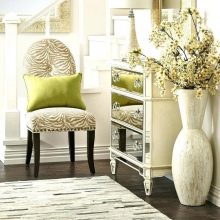
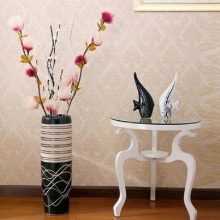
In the production of ceramics, clay is traditionally used, into which certain additives are introduced to obtain specific properties. In this regard, modern ceramic products have gone far from their ancestors. But in terms of design and style, classical approaches (up to those rooted in antiquity) remain in demand today.
In the distant past, the technology was very complex, the work was done manually. Therefore, the cost of vases turned out to be very high, and only a few could afford this rare decor item.
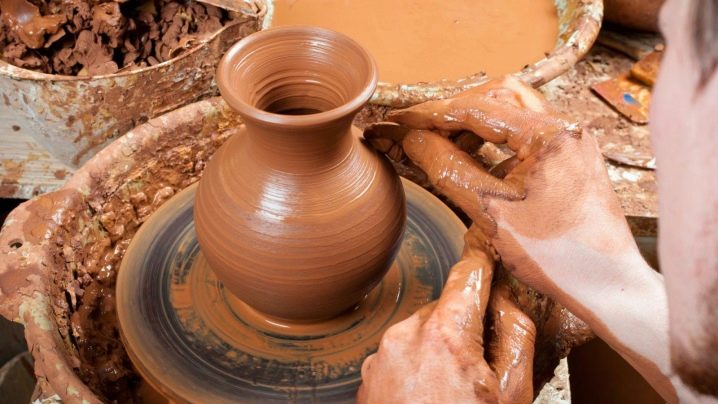
In our country, only in the twentieth century, technological development, together with a general increase in well-being, made it possible to reverse this trend. However, an unshakable rule has been preserved since antiquity: it does not matter whether a handmade vase or industrial production, it plays a huge role in the interior. Therefore, such a part of the decor must be entered into the setting very carefully and strictly.


You will learn how ceramic vases are made by watching the following video.
How to choose?
Along with clay and compositions containing it, the use of other inorganic materials has long been debugged in ceramic industries. When a finer texture is needed, porcelain is used, and if relatively rough contours are needed or economy is very important, earthenware is preferred.
To harmoniously fit a vase into a room, you need to consider:
- general style;
- geometry of the structure;
- saturation of the room with furniture;
- the presence of other decorative elements;
- product coloring;
- area of space.
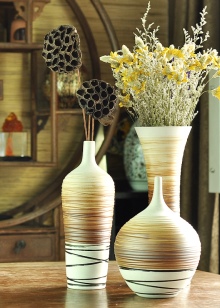

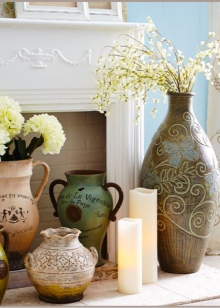
Where to apply?
An original piece of decor (for example, a tiered or vintage Slavic vase) can help divide the space into specific zones. As a decorative block in its own right, a vase often removes the feeling of an empty corner or center of a room. It also helps to emphasize other bright details in the room.



The use of lighting around the vase will help enhance the effect.
All this applies mainly to low and medium products. A high vase is preferred in spacious rooms and under stairs.
You can also apply it:
- in the guest rooms;
- in design niches;
- in the corners.


Helpful hints
- To create a more beautiful and pleasant appearance of the room, you can arrange several vases of different configurations. In winter, it is recommended to put spruce paws in them. When nature awakens, it is time for twigs with young foliage. The best option to add tenderness and romance to the interior is to use large flowers.

- Some difficulties can be caused by the design of a room, the style of which is unsteady and uncertain. In such a situation, a ceramic vase, painted in white, is often the best choice. Porcelain items in the form of bowls, which are decorated with gilded details, perfectly correspond to classical subjects.

- Many people strive to bring peace and harmony to their home. In this case, it is recommended to give preference to pastel colors and ornaments of minimal complexity. Ideally, even patterns should be abandoned, if they should be, then only tastefully selected.
- Such products can be used in a cottage, in a city apartment, and in an office. If the color of the bowl is harmoniously intertwined with wallpaper or other material on the walls, the room will appear wider. It is also a good idea to reproduce the tonality of curtains or other decorative elements in the pattern. Completely monochrome vases (blue, red, beige) work best with soft pile carpets.



How to glue?
Any vase, even a shell, needs careful maintenance. But sometimes, despite all the attention and precautions, these decorative items break. Fortunately, ceramics are easy to bond.
The best option for this purpose is a cyanoacrylate-based universal adhesive.
Such adhesives are presented today in a wide range, however, it must be borne in mind that not all of them are sufficiently resistant to water. Therefore, only some varieties are suitable for repairing vases where flowers will be placed. Alternative solutions are epoxy glue and BF-4. If the vase is made of porcelain, it is recommended to use carbinol glue. It makes no sense to describe the specific methods of use, it is still better to follow the instructions.















The comment was sent successfully.